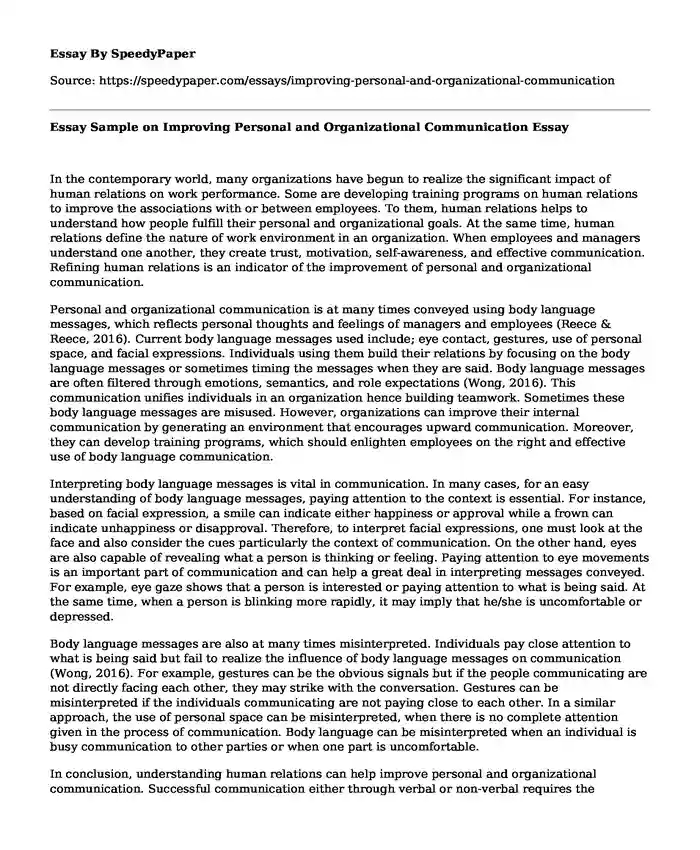
| Type of paper: | Essay |
| Categories: | Human resources Organizational behavior Interpersonal communication |
| Pages: | 3 |
| Wordcount: | 650 words |
In the contemporary world, many organizations have begun to realize the significant impact of human relations on work performance. Some are developing training programs on human relations to improve the associations with or between employees. To them, human relations helps to understand how people fulfill their personal and organizational goals. At the same time, human relations define the nature of work environment in an organization. When employees and managers understand one another, they create trust, motivation, self-awareness, and effective communication. Refining human relations is an indicator of the improvement of personal and organizational communication.
Personal and organizational communication is at many times conveyed using body language messages, which reflects personal thoughts and feelings of managers and employees (Reece & Reece, 2016). Current body language messages used include; eye contact, gestures, use of personal space, and facial expressions. Individuals using them build their relations by focusing on the body language messages or sometimes timing the messages when they are said. Body language messages are often filtered through emotions, semantics, and role expectations (Wong, 2016). This communication unifies individuals in an organization hence building teamwork. Sometimes these body language messages are misused. However, organizations can improve their internal communication by generating an environment that encourages upward communication. Moreover, they can develop training programs, which should enlighten employees on the right and effective use of body language communication.
Interpreting body language messages is vital in communication. In many cases, for an easy understanding of body language messages, paying attention to the context is essential. For instance, based on facial expression, a smile can indicate either happiness or approval while a frown can indicate unhappiness or disapproval. Therefore, to interpret facial expressions, one must look at the face and also consider the cues particularly the context of communication. On the other hand, eyes are also capable of revealing what a person is thinking or feeling. Paying attention to eye movements is an important part of communication and can help a great deal in interpreting messages conveyed. For example, eye gaze shows that a person is interested or paying attention to what is being said. At the same time, when a person is blinking more rapidly, it may imply that he/she is uncomfortable or depressed.
Body language messages are also at many times misinterpreted. Individuals pay close attention to what is being said but fail to realize the influence of body language messages on communication (Wong, 2016). For example, gestures can be the obvious signals but if the people communicating are not directly facing each other, they may strike with the conversation. Gestures can be misinterpreted if the individuals communicating are not paying close to each other. In a similar approach, the use of personal space can be misinterpreted, when there is no complete attention given in the process of communication. Body language can be misinterpreted when an individual is busy communication to other parties or when one part is uncomfortable.
In conclusion, understanding human relations can help improve personal and organizational communication. Successful communication either through verbal or non-verbal requires the involvement of humans. In a similar approach, a greater understanding of body language messages can be enhanced if individuals involved are trained to pay close attention to communication cues such as context, and at the same time be trained on the interpretation of the body language messages. Organizations, therefore, should analyze and identify ways to improve personal and organizational communication.
References
Reece, B., & Reece, M. (2016). Effective human relations: Interpersonal and organizational applications. Cengage Learning. Retrieved from: https://books.google.com/books?hl=en&lr=&id=eC0oCgAAQBAJ&oi=fnd&pg=PR7&dq=Human+relations+Improving+Personal+and+Organizational+Communication&ots=1gC58fgrCU&sig=SM3dwYVhUXsbph6LX74YAiylUkg
Wong, S. S. (2016). Emotions and the communication of intentions in face-to-face diplomacy. European Journal of International Relations, 22(1), 144-167. Retrieved from: http://www.academia.edu/download/37451338/WONG_Emotions_in_Diplomacy.pdf
Cite this page
Essay Sample on Improving Personal and Organizational Communication. (2023, Feb 12). Retrieved from https://speedypaper.net/essays/improving-personal-and-organizational-communication
Request Removal
If you are the original author of this essay and no longer wish to have it published on the SpeedyPaper website, please click below to request its removal:
- Social Mobility in the UK - Free Essay in Sociology
- New Changes to Maryland's Quiet Title Law, Free Essay
- Essay Sample with the Research Proposal Evaluation
- Free Essay Example: Renewable Energies
- Essay Sample on Difference Between A DNP and A Ph.D. in Nursing
- Free Essay. The Success in Attracting and Retaining Minorities at Pepsico
- The Impact and Effect of Compensation Within an Organization. Essay Sample
Popular categories




